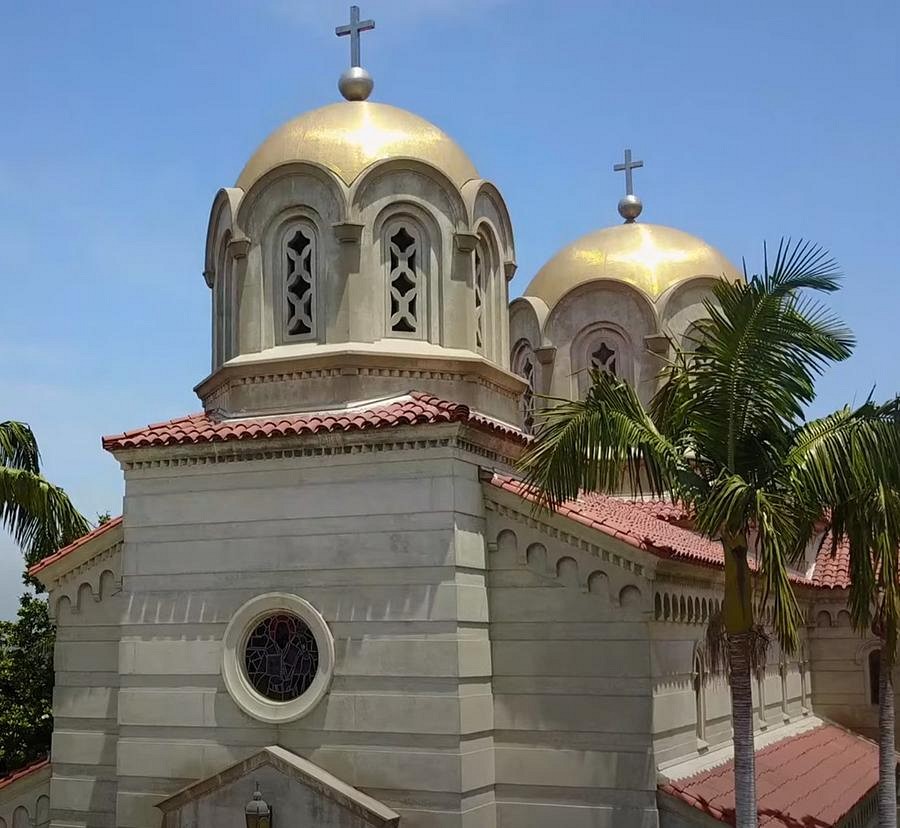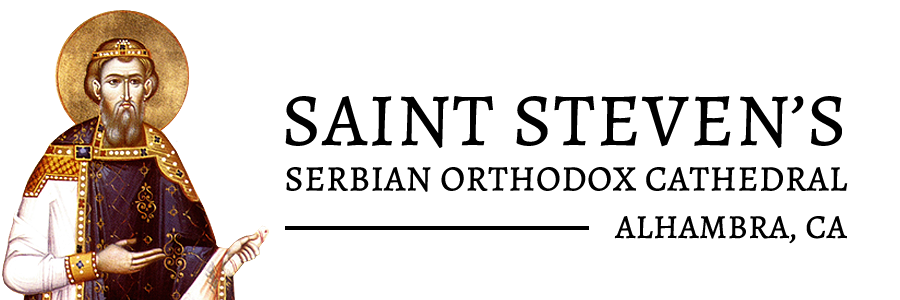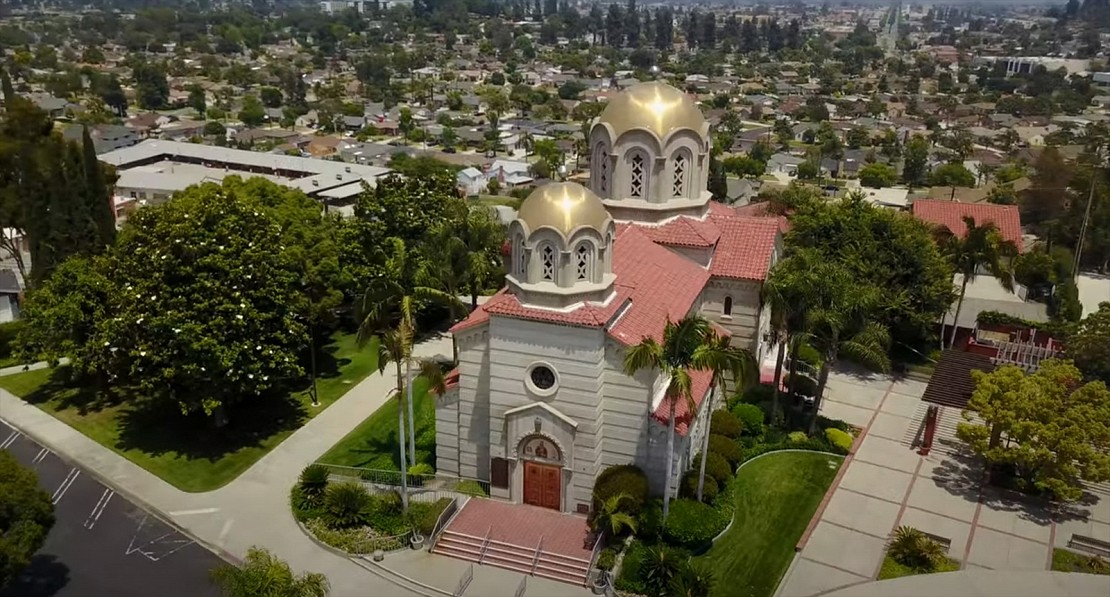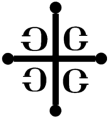“This place of ours also has its own heaven. It is this holy church. For every holy church is also a piece of heaven on earth. And whenever you are in a church, behold, you are already in heaven! And what is a church for? It is for the sake of prayer to God, for serving God in justice and in the light of truth. In the Church of Christ, we entrust ourselves to God through prayer and He teaches us His eternal Justice, His eternal Divine Truth, His eternal Goodness. And this comes about because, through prayer, a man grows more and more in every Divine goodness, in every Divine truth and justice, and in every spiritual joy. And this joy of his, this blessing, no one can take away from him either in this world or in the other.”--Our holy Father Justin Popovich,from “Velka Gospojina, 1963,” “Na Bogocovecanskom Putu"
—The words of the holy Father Justin, theologian, teacher, pastor true servant of our Lord, describe the mission of the Church—an identity which Saint Steven's Cathedral has strived to maintain and preserve in every way.
Saint Steven's Cathedral is one of the largest Orthodox churches in Los Angeles County and the United States. It includes characteristic elements from the Middle Ages, and it stands as a fine representation of Byzantine architecture typical of Serbian Orthodox churches in Byzantium. Surrounded by trees and flowers and touched by a timeless serenity, it remains fixed in resplendent grace and beauty on a knoll in Alhambra, removed from the bustling valley below.
Saint Steven's Cathedral houses many items of religious and artistic importance. It is an original composition of 12th and 13th century motifs of Byzantine and Romanesque architecture. These motifs were taken from several medieval churches and monasteries throughout the Serbian lands among: Studenica (1183-1191), the King's Church on Oplenac, Sopochani (1265), Milesevo (1234), and Dechani (1335).
God Is With Us
The church is oriented towards the East, according to the Apostolic canon: "The house of the Lord should be oriented towards the sunrise, with annexes on both sides corresponding to the nave" (1, II, 57). The church is entered from the West and the faithful standing in prayer face the East, the altar, the symbol of heaven, spiritual light and Christ—the Sun of Righteousness— who shall appear as lightning from the East at His second coming (Matthew 24;27). This style of architecture is also characterized by the attempt to reveal the fundamental experience of Orthodox Christianity which is that Christ has come, that God is with us—Immanuel— and it is this fact which determined the form of the church building. God is with man in Christ through the Holy Spirit. In the New Testament, Saint Paul writes, "We are the temple of the living God..." and it is precisely this conviction and experience that Orthodox Church architecture conveys.
The church building is divided into three main parts the sanctuary, nave and vestibule. On the walls throughout are displayed images of the principle events of salvation history. All the events that eventually led to the salvation of mankind are depicted in one form or another throughout the church. This is a constant reminder to us that our salvation begins here on earth by our participation in the Body of Christ. The theology of the interior gathering place of the faithful is that of Christ surrounded by His Church in this world.
Three artists gave of their talent and devotion to create this glorious communion of God and man. The iconostasis (altar screen) in the cathedral represents one of the great treasures of Serbian Church art, magnificently painted by Paja Jovanovic, one of the most celebrated of modern Serbian artists. Born in Vrsac, Banat, Yugoslavia in 1859, he received his first education in art in his home town. As a young student Jovanovic went to Vienna, where he was graduated with honors from the Vienna Academy of Fine Arts. Acclaimed as one of the best illustrators of Serbian history and folkways, he was elected a member of the Royal Serbian Academy of Sciences in 1888. His works won prizes and recognition in many countries, especially at the art exhibits in Vienna in 1893 and in Berlin in 1900. In Serbian art circles, Jovanovic represents an entire school of thought and expression.
On May 5, 1949 the first painting arrived from Vienna, it was his "The Last Supper," seen here over the Royal Doors of the altar. According to the artist, this painting was created to portray the New Testament description of the Supper as found in Matthew 26: 26-28; and Luke 22: 14-19. By the end of June, 1950 the last of the remaining eight paintings arrived. These included (from left to right) St. Steven the First Crowned Serbian King, Archdeacon Stephen, The Most Holy Birth-Giver of God, (Royal Doors seen on the following page), the Archangel Gabriel, The Virgin Mary, Our Lord and Saviour, The Archangel Michael, and Saint John the Baptist.
The arches on the southern and northern walls of the outer aisles contain the works of another famous artist, Marko Ivancevic. Here are depicted the four miracles of Christ: the changing of water into wine at the Wedding in Cana of Galilee (John 2:1-11), seen on the left, Christ walking on water (Matthew 14:22-33, Mark 6:45-53 and John 6:15-21), the healing of the Gadarene demonic (Matthew 8:28-34, Mark 5:1-20 and Luke 8:26-39) and the healing of the Apostle Peter's mother-in-law (Matthew 8: 14-17, Mark 1:29-34, and Luke 4:38-41), and four parables of Our Lord: the Prodigal Son (Luke 15:11-32), the rich man and Lazarus (Luke 16: 1-31), the good Samaritan (Luke 10:25-37), and the Publican and Pharisee (Luke 18:10-14).
The major contribution to the interior concept has been made by Jose Rodrigo de Soto. Through his artistic expression the cathedral has achieved the full measure of spiritual wholeness in its design. Born in Lugo, Spain, this 73-year-old artist devoted more than half a century to religious art. His hands have the talent and training of years of study at the Royal Academy in Madrid, in Paris, and at the Spanish Conservatory in Rome. The mastery of his work can be found in Italy, Spain, Canada, and throughout the United States.
The Sanctuary
The sanctuary is the place of the altar, the mystical center of the church. It represents and reveals the Throne of God to which Christ has raised us in His Glorious Ascension and before which we stand with Him in eternal adoration; the Table of the Divine Banquet, to which Christ has called us and at which He eternally distributes the food of immortality and eternal life; and the altar of His Sacrifice for us, of His total oblation to God and to us.
On the altar table is the tabernacle, in the shape of a church building, which is the repository for the gifts of holy communion that are reserved for the sick and dying.
The antimension on the altar table is a cloth depicting Christ in the tomb which contains the signature of the bishop granting permission for the local community to gather as the Church.
The cathedral has been entrusted with a portion of the relics of saints. To show that the Church is built on the blood of the martyrs and the lives of God's holy people. Resting on the altar table are a portion of the relics of Saint Lazar, the great martyr of Kosovo, which were placed there on the day the cathedral was consecrated. On the altar also are the reliquaries which house the holy relics of Saint Steven (Simon, the monk) and his mother, Saint Anastasia, side by side as are their relics in the Church of the Holy Virgin at the Studenica Monastery in Serbia.
The Mother of God, "The Image of the Church"
Seen over the altar in the sanctuary this fresco is called “The Image of the Church," since Mary is herself the prototype of the entire assembly of believers in whom Christ must dwell.
The Central Dome
Christ Pantocrator (Almighty) dominates the central dome, the highest part in the cathedral. Unlike the pointed arches traditional in churches in the West, which point to God far up in the heavens—the spacious, all-embracing dome gives the impression that in the Kingdom of God, and in the Church, as Saint Paul writes, "Christ unites all things in himself, things in heaven and things on earth." (Ephesians 1:10).
The Nave
The nave occupies the greatest expanse of the church and is the place where the Church as the body of the faithful gathers in unity of faith, hope and love to acclaim the Lord Jesus Christ, to listen to His teachings, to receive His gifts, to be edified, sanctified and renewed by the grace of the Holy Spirit. The icons of the saints on the walls, the candles and all other sacred decorations have but one meaning: the unity of the Church on earth with the Church in heaven. Assembled in the Temple, the faithful are the visible expression of the whole Church—of which Christ is the head and of which the Mother of God, the Prophets, Apostles, Martyrs and all the Saints are members. Those who gather here enter into company with the saints, form one body, and are raised into a new dimension, that of the Church in glory. Thus, to enter the Church, to be assembled, gathered with the saints, is the greatest possible gift and privilege, for the nave is truly the place of our acceptance into the Kingdom of God.
The Bishop's Cathedra
A cathedral is the bishop's own church, and as such, it is the See of the Diocese entrusted to his care. Therefore, the cathedral is the place where the bishop has his chair, or cathedra. Above the cathedra in Saint Steven's is an icon of Christ the High Priest, as is and always has been most appropriate in the Tradition of the Universal Orthodox Christian Church.
The icon of Christ the High Priest is positioned on the back of the throne as the bishop is understood as our symbolic image of Christ the High Priest in the Church. It is his place during divine services: a place from which to teach. It is not meant to be ostentatious. It is meant, however, to have a place of prominence in the Church symbolically representing the grand responsibility of the bishop within the life of the Church. It remains a place from which to both instruct and guide his faithful flock as they proceed toward the Kingdom of Heaven.
The Four Pillars
The Church is constructed with four main pillars beneath the dome. These are adorned with the icons of the four evangelists. This is symbolic of the proclamation of the "Good News" in the four corners of the world. These pillars also contain the images of the martyrs, confessors, hierarchs, and ascetic saints who are referred to as the "Pillars of the Church."
The Vestibule
Through the doors of the vestibule, which is sometimes called the narthex, the baptized are introduced into the fullness of the Church. Traditionally, baptisms begin in the narthex, and then the new members of the church are led in a solemn procession from the narthex into the church and to the baptismal font seen on the previous page. Within the narthex are two large murals. One depicts the coronation of Saint Steven at the hands of his brother, Saint Sava, on the Feast of the Ascension in the year 1222. The other depicts the reconciliation between brothers, Steven and Vukan, at the relics of their father brought to them from Mount Athos by their brother Saint Sava.

1621 West Garvey Avenue
Alhambra, CA 91803
Tue
11MarSouth Pasadena/ San Gabriel Valley Faith and Bible Study 7:00 p.m.Wed
12MarPresanctified Liturgy 7:00 p.m.Fri
14MarAkathist Hynmns Service 7:00 p.m.



